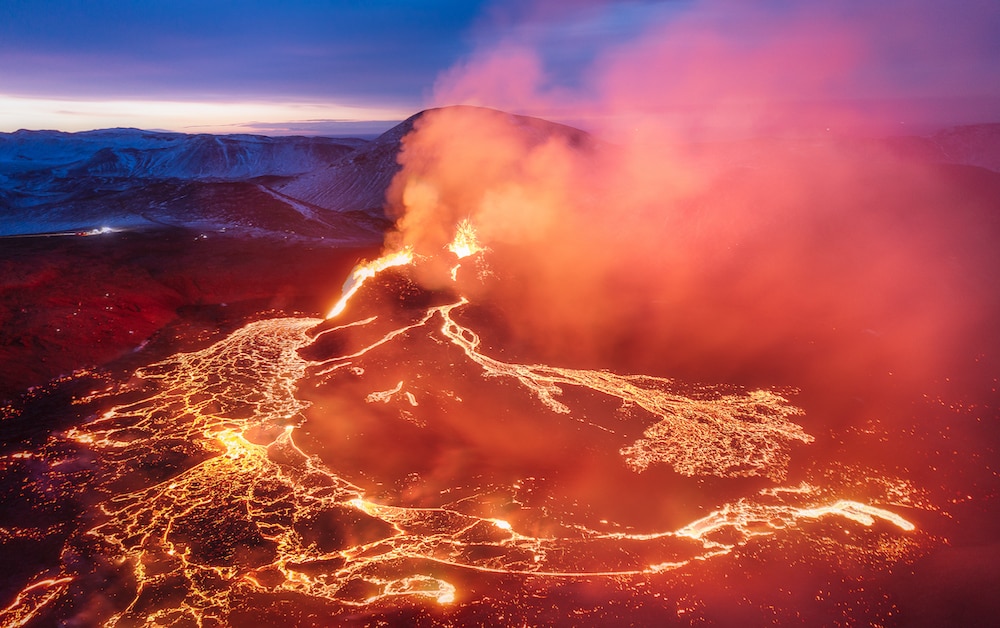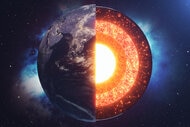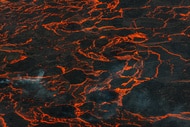Create a free profile to get unlimited access to exclusive videos, sweepstakes, and more!
Volcanoes and earthquakes could have started as far back as 3.8 billion years ago
There was a literal seismic shift some 3.8 billion years ago.

You know that explosive scene in Jurassic World: Fallen Kingdom where the volcano on Isla Nublar erupts, spewing lava onto frantic dinosaurs (and humans) fleeing for their lives?
Volcanoes started erupting long before there was any such thing as a dinosaur; 3.8 billion-year-old zircon crystals are now though to be the earliest evidence of subduction, which sets off volcanoes, tsunamis, earthquakes, and other phenomena. Older zircons do exist, but what these reveal is that the era during which they formed was most likely when tectonic activity started causing earthquakes to tremble and volcanoes to erupt.
Earth’s protocrust was much more stable before plate tectonics shook the planet. This phenomenon was thought to have started anywhere between 800 million and 4 billion years ago, but hardly anything is left over from the first 500 million years of Earth’s existence because tectonic plates are constantly shifting. Geologist Nadja Drabon of Harvard University, who led a study recently published in AGU Advances, has unearthed some primordial zircons which she has found to be some of the few elusive relics from that era. She thinks that the reason why there was a destabilization of the planet's crust is still an open question.
"Several mechanisms have been proposed, including meteorite impacts," she told SYFY WIRE. "What came first is the problem. Today, plates are broken up or weakened through plate tectonic mechanisms, but plate tectonics can obviously not be the cause of plate tectonics."
Previous hypotheses on when plate tectonics began were divided. While one assumes that our planet was either more like it is today than we thought, with plate tectonics emerging not long after the planet was born, the other says there were no plate tectonics moving around beneath the protocrust, which would melt and solidify and re-melt in certain areas. It is the first hypothesis that allows for zircons to have formed in rocks that were right at the edge of tectonic plate boundaries. Such zircons have only been found in 12 places on Earth.
When these zircons formed, the rocks they were found in are thought to have been under intense pressure and starting to melt. That could mean they emerged in subduction zones, where plates collide and one is plunged beneath the other. Zircons are time capsules that preserve pieces of a geological record that has otherwise been lost. They crystallize in magma or metamorphic rocks, which change form when they are heated or pressured to extremes (which is why they are often found where subduction occurs). The reason they survive for billions of years is their almost supernatural resistance to physical and chemical erosion. Those from 3.8 billion years ago revealed a geochemical signature—similar to that of subduction zones—that could mean early plate tectonics.
"Although some other processes can impart similar signatures, geochemistry tells us that there was a significant change in the way crustal processes operated," said Drabon. "So one possibility is the onset of some form of perhaps sluggish plate tectonics. This is why I consciously call it "mobile-lid tectonics" rather than plate tectonics."
Something evidently rocked the stable protocrust 3.8 billion years ago. What formed then is much more similar to rocks that form from plate tectonics now than they are to anything that formed before the zircons Drabon found. She and her research team had investigated some of the other rare zircon crystals that had formed in the ancient crust in a previous study, but these are even more indicative of a transition in Earth’s geological processes, when tectonic plates started disrupting the crust and upper mantle.
The researchers found that the decay of halfnium isotopes from zircon samples could give away when the crust got loose from the mantle and how long it was before any new crust formed. Earth's protocrust is now thought to have most likely formed between 4.4 and 4.2 billion years ago, and these zircons are still holding onto evidence from that protocrust, which had never erupted in molten magma before. Things changed around 3.8 billion years ago when mobile-lid tectonics appear to have begun.
"It is likely that the evolution towards plate tectonics was not something that happened in an instant, but was probably a complex process that took a while," Drabon said. "The transition that we see at 3.8 Ga in the zircon signatures is certainly a very important step towards the modern plate tectonic system we have today."
What was Earth even like without plate tectonics? It would have probably gone from scorching to freezing if crust wasn’t being recycled and re-formed over and over. These processes, which might have threatened the dinosaurs that were living out of time on Isla Nublar, are actually something of an air conditioning system that resets automatically. Volcanic gases are released, but the silicate rocks that form in the wake of subduction events consume mass quantities of atmospheric carbon dioxide in those gases and elsewhere, controlling greenhouse gas levels.
Earth is the only planet known to have plate tectonics. Drabon thinks that evidence of primordial tectonic activity could possibly help us find out more about what could have happened in the distant past on alien planets, and whether their conditions were or still are ideal to support life (at least as we know it).
"Having some record of the pre-plate tectonic time on Earth can provide us with a physical record," she said. "With this, we can directly probe to understand the dynamics of a planet without plate tectonics, since physical samples from other planets are rare."


























